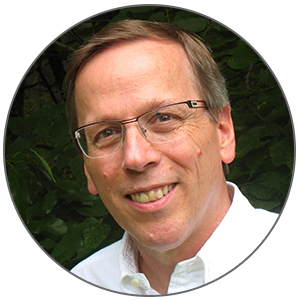The scientific evidence for lucid dreaming normally starts with the ingenious work of Keith Hearne, Ph.D. at the University of Hull (UK) in 1975 and Stephen LaBerge, PhD at Stanford University in 1978. While graduate students, they separately imagined an experimental process to provide clear evidence that a dreamer could become consciously aware of dreaming, while in the dream state.
Hearne and LaBerge understood that while dreaming, people normally have Rapid Eye Movement (REM). They both hypothesized that someone with lucid dreaming skills could be brought to the sleep lab, wear a REM polygraph monitor and then ‘signal’ their lucid awareness by moving their eyes left to right a predetermined number of times once they became lucidly aware in a dream. If the researchers saw this very unusual set of left-right eye ‘signals’ on the REM readout, then this would provide credible evidence for lucid dreaming — or being consciously aware in the dream state and able to recall and perform intentional acts. Other monitoring devices would confirm that they remained asleep.
Join us for a free webinar!
Lucid Dreaming: The Science, Practice, and Potential
presented by
Robert Waggoner
Friday, February 12, 2021
11:00 am – 12:15pm (Pacific)
Hearne, working in the sleep lab with the talented lucid dreamer, Alan Worsley, captured this eye-signal verification evidence in April 1975 on the REM polygraph readout. LaBerge, using himself as the lucid dreaming subject in the Stanford sleep lab, captured his lucid eye-signals in early 1978.
Looking back at that first scientifically acceptable evidence for lucid dreaming, Keith Hearne said, “It was like getting signals from another world. Philosophically, scientifically, it was simply mind blowing.”
Stephen LaBerge noted that when he presented his scientific research to the prestigious journal Science, one of the reviewers adamantly refused to believe that it was possible to become lucidly aware in the dream state, so it was rejected for publication. When he sought publication in Nature, they did not review the study, deeming the topic “not of sufficient general interest”. Eventually his research was accepted by the peer reviewed Journal of Perceptual and Motor Skills in 1980.
With the publication of LaBerge’s discovery in Psychology Today (Jan. 1981), many of us learned of the scientific evidence in support of lucid dreaming. Hearne also published and discussed his results at various events and publications (see his website for more details). LaBerge’s 1985 book, Lucid Dreaming, provided additional research, experiential advice and insight into lucid dreaming, which helped him become a widely read author and noted researcher in the emerging science of lucid dreaming.
Before the evidence from LaBerge and Hearne, the idea and experience of lucid dreaming existed; however, the lack of scientific evidence left it in doubt and even considered impossible by many. Books from that time by authors, like Celia Green (Lucid Dreams, 1968), Carlos Castaneda (Journey to Ixtlan, 1972), Patricia Garfield (Creative Dreaming, 1974) and G. Scott Sparrow (Lucid Dreaming: Dawning of the Clear Light, 1976) re-energized the topic and provided some fascinating anecdotes about lucid dreaming. Yet, until the scientific evidence emerged, lucid dreaming seemed too incredible to take seriously.
Lucid Dreaming as a Spiritual Practice
Historically, however, lucid dreaming has a deep and honored place as a spiritual practice in many wisdom traditions, such as Buddhism, Sufism, Taoism, shamanism and other native traditions. Some authors, like Tenzin Wangyal Rinpoche, suggest that the Tibetan shamanic Bon tradition knew about and utilized lucid dreaming for many thousands of years before lucid dreaming became part of the Buddhist dream yoga practices. The 11th century Buddhist yogi, Naropa, deemed dream yoga (which relies deeply on the practice of lucid dreaming) as one of the six paths to enlightenment.
Interestingly, The Letters of St. Augustine, made note of a lucid dream by an early Christian physician, Gennadius, who wondered about the actual nature of life after death. In Letter 159, St. Augustine tells the story of how Gennadius met a remarkable “youth” in a regular dream and heard holy music:
“On a second night, however, the same youth appeared to Gennadius, and asked whether he recognised him, to which he replied that he knew him well, without the slightest uncertainty. Thereupon he asked Gennadius where he had become acquainted with him…. [Gennadius shares the dream from the night before.] On this the youth inquired whether it was in sleep or when awake that he had seen what he had just narrated. Gennadius answered: In sleep. The youth then said: You remember it well; it is true that you saw these things in sleep, but I would have you know that even now you are seeing in sleep. Hearing this, Gennadius was persuaded of its truth, and in his reply declared that he believed it.
Then his teacher went on to say: Where is your body now? He answered: In my bed. Do you know, said the youth, that the eyes in this body of yours are now bound and closed, and at rest, and that with these eyes you are seeing nothing? He answered: I know it. What, then, said the youth, are the eyes with which you see me? He, unable to discover what to answer to this, was silent. While he hesitated, the youth… said: As while you are asleep and lying on your bed these eyes of your body are now unemployed and doing nothing, and yet you have eyes with which you behold me, and enjoy this vision, so, after your death, while your bodily eyes shall be wholly inactive, there shall be in you a life by which you shall still live, and a faculty of perception by which you shall still perceive.”
Source: Translated by J.G. Cunningham. From Nicene and Post-Nicene Fathers, First Series, Vol. 1. Edited by Philip Schaff. (Buffalo, NY: Christian Literature Publishing Co., 1887.) Revised and edited for New Advent by Kevin Knight.
Many modern day lucid dreamers can recount similar lucid dreams of being prompted to lucid awareness by inquisitive dream figures. I recall walking across a conference room floor, when a man in a robe asked me, “What is that book you are carrying?” I stopped, looked at the book cover and said, “It’s Dreams: God’s Forgotten Language by John A. Sanford.” As I said those words, I suddenly realized that I had purchased the book, but had yet to read it! I immediately understood that I was dreaming and became lucidly aware.
Because lucid dreaming seems an open platform for most any activity, practitioners can learn to perform spiritual practices in lucid dreams, such as meditating in a lucid dream. Many note that such an experience leads very quickly to profound feelings of inter-connectedness and transcendence.
Selected Research Since the 1980s
Surveys have shown that the experience of lucid dreaming seems relatively common. For example, a survey of Japanese college students, asked if they had ever experienced being consciously aware of dreaming while in the dream state. Of those surveyed, 47% reported at least one experience. The researchers contrasted this to other studies which showed the following reports of one incident of lucid dream awareness in 71% of USA students, 82% in Germany and 73% in the Netherlands. Approximately one in four of these students were considered frequent lucid dreamers, since they reported having at least one lucid dream per month on average.
Erlacher, Daniel; Schredl, Michael; Watanabe, Tsuneo; Yamana, Jun; Gantzert, Florian. The Incidence of Lucid Dreaming within a Japanese University Student Sample, International Journal of Dream Research, Vol 1, No 2 (October 2008) (2008).
Another research team, led by Ursula Voss, dealt with 694 German school children ages 6 to 19 years to investigate the onset of lucid dreaming. Altogether, they discovered that 51% of the school children could recount a lucid dream. Additionally they noted that almost 20% of the eight year old children had already had lucid dreams naturally. The researchers mentioned many of these students exhibited an ability to influence the course of the lucid dream, even though “these students had no training [in lucid dreaming] and lucid dreaming occurred spontaneously.”
More recently, scientists have continued to investigate brain activity when lucid dreaming. In 2009, the journal SLEEP, published a study, Lucid Dreaming: A State of Consciousness with Features of Both Waking and Non-Lucid Dreaming by Ursula Voss, J. Allan Hobson and others. In the study, they used a 19-channel EEG to record brain activity when the subjects were lucid dreaming. They discovered simultaneous REM sleep brain activity along with some waking activity in the frontal portions of the cerebral cortex. From this, they concluded, “Our data show that lucid dreaming constitutes a hybrid state of consciousness with definable and measurable differences from waking and from REM sleep, particularly in frontal areas.”
Another study in the journal SLEEP (2012), looked more closely at the precise areas of brain activity while lucid dreaming. The authors of the report, Neural Correlates of Dream Lucidity Obtained from Contrasting Lucid versus Non-lucid REM Sleep: a Combined EEG/fMRI Case Study, determined that “During lucid dreaming, the bilateral precuneus, cuneus, parietal lobules, and prefrontal and occiptio-temporal cortices activated strongly as compared with non-lucid REM sleep.” These portions of the brain connect with mental processes like self-assessment, evaluating thoughts and feelings, and self-perception, which lucid dreamers often note in their self-reported lucid dreams.
While exciting in many ways, neuro-physiological research looks at the brain’s experience of the lucid dream. But what about the lucid dreamer’s experience?
What can science tell us about ‘how’ a lucid dreamer should relate to a threatening dream figure? Or what can science tell a lucid dreamer about seeking creativity, while consciously aware in a dream? How can you study ‘consciousness’ while being aware within the subconscious of a lucid dream?
In the coming workshop at IONS with your facilitators Robert Waggoner, Gillian Thetford, and Ed Kellogg, we explore these very important practical and conceptual needs of the lucid dreamer. Becoming consciously aware in the lucid dream seems the first step — you also need to understand ‘how’ to relate to the lucid dream, stabilize it and explore within it. By learning the principles and practices in the workshop, you will be prepared to experience lucid dreaming at a more advanced level.
© 2021 Robert Waggoner
About the Author
 Author Robert Waggoner is the past President of the International Association for the Study of Dreams (IASD). For the past ten years, he has been the co-editor of the online magazine, The Lucid Dreaming Experience, the only ongoing publication devoted specifically to lucid dreaming. A lucid dreamer since 1975, he has logged more than 1,000 lucid dreams.
Author Robert Waggoner is the past President of the International Association for the Study of Dreams (IASD). For the past ten years, he has been the co-editor of the online magazine, The Lucid Dreaming Experience, the only ongoing publication devoted specifically to lucid dreaming. A lucid dreamer since 1975, he has logged more than 1,000 lucid dreams.
Robert’s first book, Lucid Dreaming: Gateway to the Inner Self, shows how lucid dreamers can explore the subconscious and its knowing. With fascinating lucid dream examples, thought-provoking questions and exciting techniques, it has been hailed “a classic” by experienced lucid dreamers. His latest book, Lucid Dreaming, Plain and Simple: Tips and Techniques for Insight, Creativity and Personal Growth, written in collaboration with Carolina McCready, was called the “perfect book for beginners” by easy-lucid-dreaming.com.
